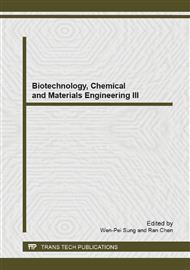[1]
Hata T, Tanaka R, Ohmomo S. Isolation and characterization of plantaricin ASM1: A new bacteriocin produced by Lactobacillus plantarum A-1. International Journal of Food Microbiology, 2010, 137(1): 94-99.
DOI: 10.1016/j.ijfoodmicro.2009.10.021
Google Scholar
[2]
Botes M, van Reenen CA, Dicks LM. Evaluation of Enterococcus mundtii ST4SA and Lactobacillus plantarum 423 as probiotics by using a gastro-intestinal model with infant milk formulations as substrate. International Journal of Food Microbiology, 2008, 128(2): 362-370.
DOI: 10.1016/j.ijfoodmicro.2008.09.016
Google Scholar
[3]
Surono IS, Koestomo FP, Novitasari N et al. Novel probiotic Enterococcus faecium IS-27526 supplementation increased total salivary sIgA level and bodyweight of pre-school children: A pilot study. Anaerobe, 2011, 17(6): 496-500.
DOI: 10.1016/j.anaerobe.2011.06.003
Google Scholar
[4]
Bhardwaj A, Gupta H, Kapila S et al. Safety assessment and evaluation of probiotic potential of bacteriocinogenic Enterococcus faecium KH 24 strain under in vitro and in vivo conditions. International Journal of Food Microbiology, 2010, 141(3): 156-164.
DOI: 10.1016/j.ijfoodmicro.2010.05.001
Google Scholar
[5]
Antonio CM, Abriouel H, López RL et al. Enhanced bactericidal activity of enterocin AS-48 in combination with essential oils, natural bioactive compounds and chemical preservatives against Listeria monocytogenes in ready-to-eat salad. Food and Chemical Toxicology, 2009, 47(9): 2216-2223.
DOI: 10.1016/j.fct.2009.06.012
Google Scholar
[6]
Ibarguren C, Raya RR, Apella MC et al. Enterococcus faecium isolated from honey synthesized bacteriocin-like substances active against different Listeria monocytogenes strains. The Journal of Microbiology, 2010, 48(1): 44-52.
DOI: 10.1007/s12275-009-0177-8
Google Scholar
[7]
WenLi Liu, LanWei Zhang, John Shi et al.: submitted to Advance Materials Research (2013).
Google Scholar
[8]
SCHILLINGER, U. & L CKE, F. K. Antibacterial activity of Lactobacillus sake isolated from meat. Applied and Environmental Microbiology, 1989, 55, 1901-(1906).
DOI: 10.1128/aem.55.8.1901-1906.1989
Google Scholar
[9]
GURBAN OGLU GULAHMADOV, S., BATDORJ, B., DALGALARRONDO, M., CHOBERT, J. -M., ALEKPER OGLU KULIEV, A. & HAERTL , T. Characterization of bacteriocin-like inhibitory substances (BLIS) from lactic acid bacteria isolated from traditional Azerbaijani cheeses. European Food Research and Technology, 2006, 224, 229-235.
DOI: 10.1007/s00217-006-0338-5
Google Scholar


